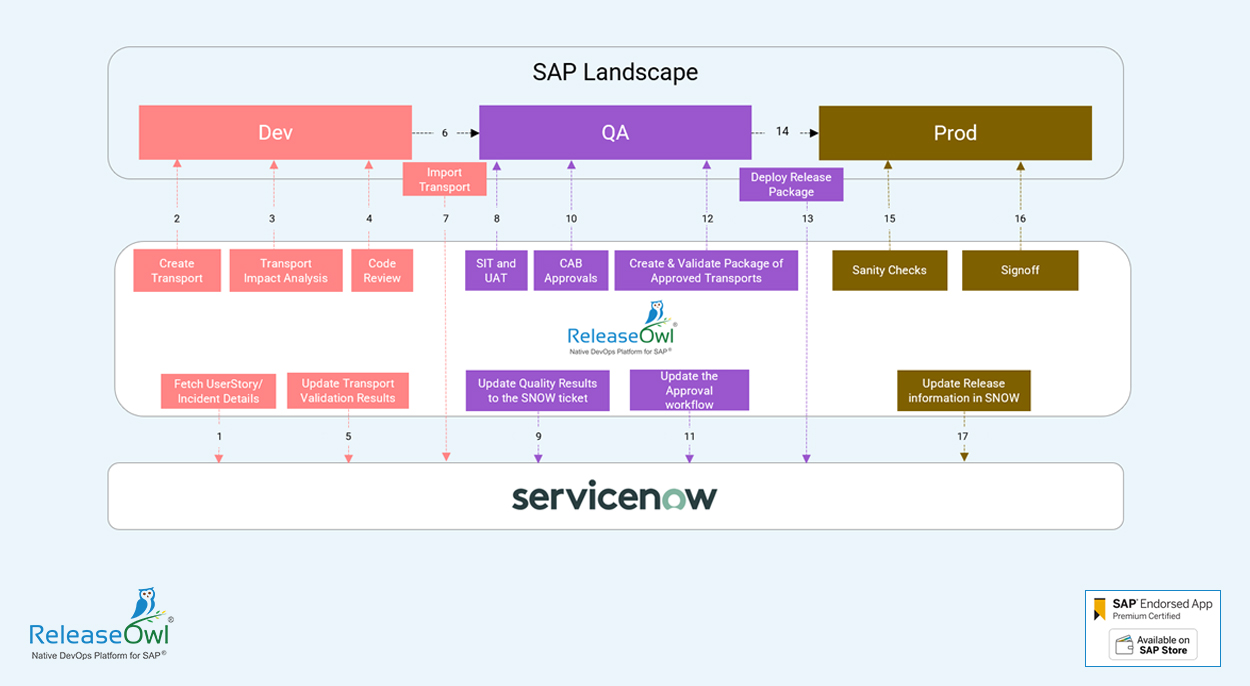The evolution of formal IT Service Management (ITSM) tooling along with the IT Infrastructure Library (ITIL) with all the standards and best practices, has brought in a new dimension for change management and governance in IT.
ServiceNow has emerged as a cloud software leader in the space of IT Service Management Tools and has seen increased adoption of the ITSM platform by most of the world’s largest companies.
While the ServiceNow ITSM platform is of great help to IT teams in tracking the life cycle of a change, the actual implementation of change is done either manually or with enterprise-grade DevOps tooling by a separate Ops team.
SAP DevOps and ReleaseOwl
There is a big evolutionary shift that is in progress for the SAP world moving from on-premise to cloud. We see customers in three different stages of application development and maintenance with SAP applications.
- Customers on SAP on-premise (ECC, S/4 HANA) working with traditional transport management for importing (deploying) the changes.
- Customers who are migrating from On-premises to Cloud Implementation
- Customers who have started new application development from scratch on SAP BTP.
ReleaseOwl is a native Platform for SAP that does automated packaging, deployment, testing, compliance, and audit for applications built on SAP on-premise or on SAP BTP.
In short, while ServiceNow can manage the business lifecycle of the change, ReleaseOwl will handle the actual process of technical implementation of the change that is powered by DevOps and automation.
What do ReleaseOwl and ServiceNow integration offer?
Increased Collaboration: ReleaseOwl will serve as an efficient collaboration medium between the customer service teams and SAP development teams for quick access to the status of the ticket/incident.
Full Visibility for change: Real-time visibility of a change both in the perspective of change management life cycle (with approvals) as well as environment management (with deployments) will help leadership teams to review the progress and make informed decisions in case of any delays.
Traceability: Traceability of a change from production to development along with all the approval information as well as the test results at each step helps in establishing a strong compliance practice as well in better root cause analysis of any issue to resolve it faster.
ReleaseOwl and ServiceNow Integration typical workflow
Here is the sequence of steps from the workflow
- The integration starts once a change is approved in ServiceNow and assigned to a developer. The same is updated in ReleaseOwl (bi-directional sync).
- SAP Application teams will perform the following actions:
- Create a transport for the change to be implemented.
- Ensure that the development and unit testing for the change is completed.
- Perform Transport Impact Analysis in ReleaseOwl (Sequence Checks, Package version checks, Dependency checks, Critical Object checks, Unit Testing, Code Coverage, and ATC compliance checks)
- Imports the transport into QA / Add it to a release package to be deployed later as a release package.
- Every step of the transport lifecycle will be updated to SNOW tickets.
- The changes are tested by SIT, QA, and UAT stakeholders.
- The test results are updated to the SNOW ticket.
- CAB Approvals flows are kicked-off from SNOW and updated in ReleaseOwl
- Once Approvals are done, the tickets are added to a release package.
- The release package is then validated for compliance and any deployment issues.
- The release package is then deployed to Production followed by sanity checks and sign-off
- The Release Information is updated to SNOW.
Conclusion
ServiceNow is the leading ITSM solution today used by many enterprises and ReleaseOwl is the native DevOps Platform designed for SAP Applications built on-premise and on cloud. This bi-directional integration ensures that both business and technology users are part of a well collaborated automated change management process for SAP applications.






Leave A Comment